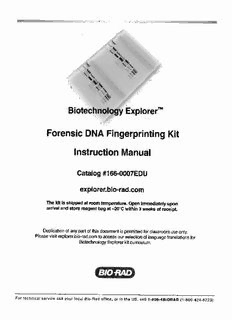
Forensic DNA Fingerprinting Kit Instruction - Amherst College PDF
Preview Forensic DNA Fingerprinting Kit Instruction - Amherst College
ETxpMlorer Forensic DNA Fingerprinting Kit Instruction Manual Catalog #1 66-0007EDU explorer.bio-rad.com The kit is shipped at room temperature. Open immediately upon arrival and store reagent bag at—20°C within 3 weeks of receipt. Duplication of any part of this document is permitted for classroom use only. Please visit explorer.bio-racLcomto access our selection of language translations for Biotechnology Explorer kit curriculum. For technical service call your local Bio-Rad office, or in the US, call 1-800-4BIORAD (1-800-424-6723) Can DNAevidencesolvehuman problems? DNAfingerprinting is now used routinelytosolvecrimes. In recentyears, newsstories have reported howmiriisculeamountsofDNAhavebeen usedto identifyindividualsinvolved in incidentseven manyyearsinthe past, aswell asexonerate innocentpeoplefrom incrimi nation. The powerof DNAasatoolforindividual identificationcapturesstudents’ imaginations. Thisactivityprovidesin-depth instructionabouthowrestrictionenzymescleave DNA, how electrophoresisasusedtoseparateandvisualize DNAfragments and howthesetechniques can becombinedtoobtain a DNAfingerprint. Principlesofrestriction analysis, plasmid mappingand DNAfragmentsizedeterminationcan alsobedocumentedwiththis kit. Openthe doorto rich discussionsaboutscientific, ethical, and legal implicationsof DNA profiling DNAfingerpnnting is used in medicalandforensicprocedures aswell as in paternitydeterminationstodiscerngeneticrelationshipsbetweenindMdualsatthemolecular level. This kitallowsstudentstoplaythe role ofaforensicscientistand makeapositive ID—thatis, tosimulate using real DNAas evidenceandfigureoutforthemselves: “Who done it?” Inthisactivity, studentsanalyzesixdifferentsamplesofplasmid DNA. Onesamplecollected from ahypothetical“crime scene”andfivesamplesobtainedfrom “suspects”aredigested withtwo restriction enzymes. The resulting DNAfragmentsareseparated andvisualized in agarosegels using Bio-Rad’sFast BlastTM DNA stainingsolution. Based onthe restriction fragmentpatterns, studentscomparetheevidenceand matchoneofthesuspects’ DNAto thesamplecollected atthecrimescene. Asanalternativetotheclassicalhumanforensicapplicationsforthiskit, haveyourstudents imaginetheyarehightech pathologists investigatinganoutbreakofan aggressiveinfectious diseasethathasneverbeenseen before.TheCentersforDiseaseControland Prevention suspectsthatanewstrainofbacteriahasarisenthatnotonlyisthecauseofthenewdisease, butalsohasacquiredmultipleresistanceplasmidsfromsomeotherbacterialstrains. Their jobistodevelopa DNAdiagnostictoolforidentifyingtheculpritplasmids. Theydecideto use restrictionenzymeanalysisand“DNAelectrophoresisfingerpnnting”to identifyand distinguish differentsuspectplasmidsandtracktheirspreadthroughtheenvironment DNA fromtheculturesofanumberofstricken patientshasbeen isolated. Haveyourstudents identifythe newkillerbug beforethepathogen getsoutintothegeneralpopulation and startsatrueepidemic! We strivetocontinuallyimproveourBiotechnology Explorerkitsandcurricula. Please shareyourstories, commentsandsuggestions! Youcandownloadthiscomplete instructionmanualonthe Internet. Visit usontheWebat explorerbio-racLcomorcall usinthe USat I-800-4BIORAD (1-800-424-6723). Thiscurriculum wasdeveloped in collaborationwith Len Poli and RussJanigianofthe SF. Base BiotechnologyProgram in San Francisco California and PeggySkinnerofthe Bush School in Seattle, Washington. We’d liketothankthemfortheirinvaluableguidanceand contributionstothiscurrkulum. Ron Mardigian BiotechnologyExplorerProgram Bio-Rad Life ScienceGroup 2000Alfred Nobel Drive Hercules, California94547 Visualization of DNA Fragments 1. When the electrophoresis run iscomplete, turn off the power and remove the top of thechamber. Carefully removethegel and trayfrom thegel box. Be careful the gel — is very slippery. Slide the gel into the staining tray. 2. You havetwooptionsforstainingyourgel: Quickstaining (requires 12—15 minutes) a. Add 120 ml of lOOx Fast Blast DNA stain into a staining tray (2 gels per tray). b. Stain the gels for 2 minutes with gentle agitation. Save the used stain forfuture use. c. Transfer the gels into a large washing container and rinse with warm (40—55°C) tap water for approximately 10 seconds. d. Destain bywashing twice in warmtap waterfor 5 minutes each with gentle shaking for best results. e. Record results. f. Trim away any unloaded lanes. U— U g. Air-drythe gel on gel supportfilm and tapethedried gel intoyourlaboratory notebook. Overnight staining a. Add 120 ml of lx Fast Blast DNA stain to the staining tray (2 gels per tray). b. Let the gels stain overnight, with gentle shaking for best results. No destaining is required. c. Pour off the stain into a waste beaker. d. Record results. e. Trim away any unloaded lanes. f. Air-drythe gel on gel supportfilm and tapethe dried gel intoyourlaboratory notebook. StudentManual 22 Student Manual Pre-Lab Introduction to DNA Fingerprinting You areaboutto perform aprocedureknown as DNAfingerprinting. Thedataobtained mayallowyoutodetermine ifthesamplesof DNAthatyouwillbe providedwith arefromthe sameindMdualorfrom differentindividuals. Forthisexperiment itisnecessaryto reviewthe structureof DNA molecules. DNAconsistsofaseriesofnitrogenousbase moleculesheldtogetherbyweakhydrogen bonds. These base pairsare in turn bondedtoasugar-phosphatebackbone. Thefour nitrogenousbasesareadenine, thymine,guanine, andcytosine (A, T, G, and C). Rememberthe base-pairing rule isA Tand G C. Refertothefigure belowofa DNA - - molecule. TheStructureofDNA The schematics above representaverysmall section of DNAfrom three different individuals. In this representation of DNAthe symbol system is asfollows: Backbone: S= Fivecarbon sugarmolecule known asdeoxyribose p= Phosphate group DNA NucleotideBases: A=adenine C =cytosine G guanine T=thymine Analysisofthethree DNAsamplesabove (see nextpage) mighthelp usdetect similaritiesand differencesin samplesof DNAfrom differentpeople. StudentManual 23 Pre-Lab Focus Questions: Introduction to DNA Fingerprinting Consideration What isthestructureofDNA? 1 Comparethe“backbone”ofthesugar-phosphate arrangementinthesidechains ofall threefigures. Arethereanydifferences? 2. Intheabovefigure, doallthreesamplescontainthe same bases? Describeyour observations. a Arethe bases paired in an identical mannerin allthreesamples? Describethe pattern ofthe base pairbonding. 4. Inyourattempttoanalyze DNAsamplesfromthreedifferentindividuals, whatcondusions canyoumakeaboutthesimilaritiesanddifferencesofthe DNAsamples? 5. Whatwillyou need tocompare betweenthese DNAsamplestodetermineiftheyare identicalornon-identical? StudentManual 24 IIII ’ 5. i I I 4 i I I 1 S. i I 5. l i I jri p - I t” J i 5 “ I l i i Im i l S 4 n m e a w I ’I 1 h t l 1 ! t f ji ‘ F gjrIIIIr IS ta IR t i l g I, IIIg I Ltt ___________ ______________ 4 DNAfragmentsizecanbeexpressedasthenumberofbasepairsinthefragment. Indicate thesizeofthefragments[mentionanydiscrepancyyoumaydetect]. a) Thesmallerfragmentis base pairs (bp). b) Whatisthe length ofthe longerfragment? 5 ConsiderthetwosamplesofDNAshown below-singlestrandsareshownforsimplicity: Sample#1 CAGTGATCTCGAATTCGCTAGTAACGTT Sample#2 TCATGAATTCCTGGAATCAGCAAATGCA Ifboth samples aretreatedwiththe restriction enzyme EcoRl [recognition sequence GAATTC]then indicatethe numberoffragments and thesizeofeachfragmentfrom each sampleofDNA. Sample# I Sample#2 #offragments: #offragments:_________ Listfragmentsize in order: largest —>smallest Sample# I Sample#2 StudentManual 26 Post-Lab: Analysis of Results Ifthe overnightstaining protocol wasusedto stain gels, record yourresults and drygelsas described in the gel staining procedures in Lesson 2 page 38. Attachthe plasticsheettracingofthe banding patternsfromthe DNAelectrophoresis below. Tracingofetectrophoresisgel Attachthe driedgel showingthe banding patternsfromthe DNAelectrophoresis below. <0 Dnedelectrophoresisgel I Z StudentManual 0 41
Description: